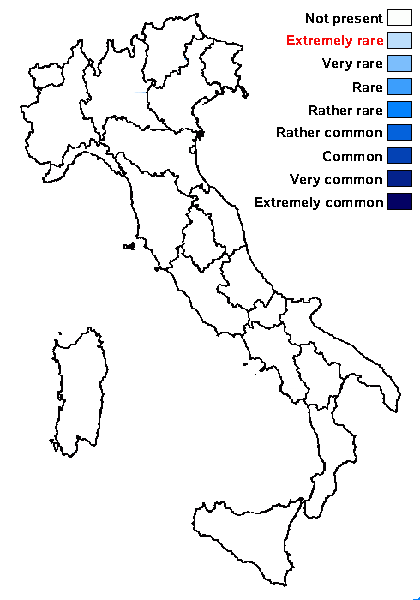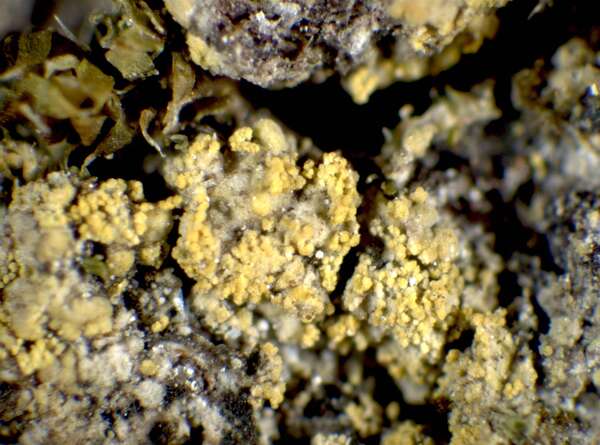Flavoplaca citrina (Hoffm.) Arup, Frödén & Søchting
Nord. J. Bot., 31: 44, 2013. Basionym: Verrucaria citrina Hoffm. - Deutschl. Fl.: 198, 1796.
Synonyms: Blastenia citrina (Hoffm.) B. de Lesd.; Callopisma citrinum (Hoffm.) A. Massal.; Caloplaca citrina (Hoffm.) Th. Fr.; Lecanora citrina (Hoffm.) Ach.; Lecanora murorum var. citrina (Hoffm.) Rabenh.; Lichen citrinus (Hoffm.) Ach.; Parmelia parietina var. citrina (Hoffm.) Schaer.; Placodium citrinum (Hoffm.) Hepp; Pyrenodesmia citrina (Hoffm.) Trevis.
Distribution:
Description: Thallus crustose, of scattered to continuous, 0.1-1(-1.5) mm wide areoles which soon dissolve into soredia, the esorediate parts flat to convex, pale greenish yellow to orange-yellow. Soredia concolorous with thallus, (25-)30-60(-75) µm. Cortex poorly developed or indistinctly paraplectenchymatous. Apothecia adnate to sessile, zeorine, 0.3-1.5 mm across, with a slightly concave to convex, yellow to yellow-orange disc, a slightly raised or level proper margin and a crenulate-sorediate thalline margin. Proper exciple (10-)25-50(-75) µm thick, of irregularly radiating, thick-walled, rather short-celled hyphae; epithecium yellowish orange, inspersed with granules, K+ red; hymenium colourless, 70-80 µm high; paraphyses simple to sparingly branched in upper part, 2-2.5 µm thick at base, the upper cells swollen, to 7 µm thick; hypothecium colourless. Asci 8-spored, cylindrical-clavate, functionally unitunicate, apically thickened with a broad internal beak, the inner part of apex and external cap I+ blue, Teloschistes-type. Ascospores 2-celled, polarilocular, ellipsoid to broadly ellipsoid, 10-15 x (4-)5-7(-8) µm, the equatorial thickening (“septum”) (2.5–)3-5(-5) µm. Pycnidia immersed, orange. Conidia bacilliform to broadly ellipsoid, 2.5-3.8 x 1-1.5 µm. Photobiont chlorococcoid. Spot tests: thallus and apothecia K+ red, C-, KC-, P-. Chemistry: thallus and apothecia with parietin (major), fallacinal, emodin, teloschistin and parietinic acid (minor), corresponding with chemosyndrome A of Søchting (1997). Note: this species was often claimed to be an almost cosmopolitan lichen. However, after the molecular revision of the entire complex by Vondrák & al. (2009), it seems that the species has a rather restricted distribution mainly in central Europe, being largely substituted by other species in the Mediterranean Region. The species complex, which still needs a thorough revision in Italy, occurs on a wide variety of substrata, from asbestos-cement, concrete and mortar to basic siliceous rocks or even eutrophicated wood, is very tolerant to, and even favoured by eutrophication (e.g. urine-deposits), and is common also in urban areas and along the main highways. See also notes on F. arcis, F. austrocitrina, F. flavocitrina, F. communis, F. confusa, and F. limonia.
Growth form: Crustose
Substrata: rocks
Photobiont: green algae other than Trentepohlia
Reproductive strategy: mainly asexual, by soredia, or soredia-like structures (e.g. blastidia)
Pioneer species
Commonnes-rarity: (info)
Alpine belt: absent
Subalpine belt: absent
Oromediterranean belt: absent
Montane belt: absent
Submediterranean belt: absent
Padanian area: absent
Humid submediterranean belt: absent
Humid mediterranean belt: absent
Dry mediterranean belt: absent

Predictive model
Herbarium samples
Growth form: Crustose
Substrata: rocks
Photobiont: green algae other than Trentepohlia
Reproductive strategy: mainly asexual, by soredia, or soredia-like structures (e.g. blastidia)
Pioneer species
Commonnes-rarity: (info)
Alpine belt: absent
Subalpine belt: absent
Oromediterranean belt: absent
Montane belt: absent
Submediterranean belt: absent
Padanian area: absent
Humid submediterranean belt: absent
Humid mediterranean belt: absent
Dry mediterranean belt: absent

Predictive model
| Herbarium samples |
 Index Fungorum
Index Fungorum
 GBIF
GBIF



